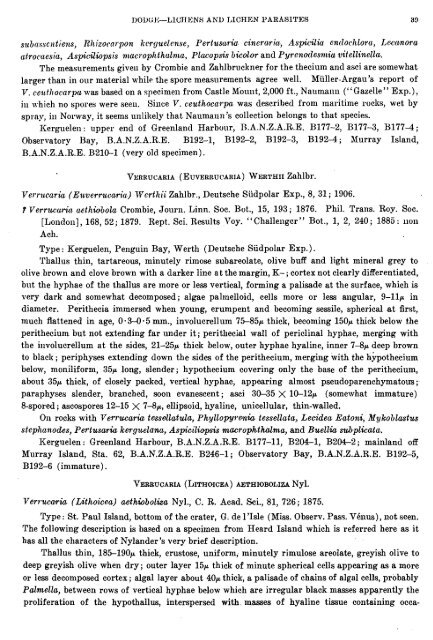Create successful ePaper yourself
Turn your PDF publications into a flip-book with our unique Google optimized e-Paper software.
DOD(:IS--LlCIII.:NS Ah'l) LICIIEN <strong>PARASITES</strong> 39<br />
sztbms.soztie~zs, Rltizocnt.pon kergudense, Pertusuriu ~ineru~riu,, Aspkiliu entlockloru, Le&tinoru<br />
nfrocaesia, Aspicilwpsis n~ucrophthulnta, Plueops-is bicolor and Pyrenotlesntiu vitellinellu..<br />
The measurements give11 by Crombie and Zahlbrucltner for the thecium and asci are somewhat<br />
larger than in our material while the spore measurements agree well. Muller-Argau's report of<br />
V. cezttllocarpu was based on a specimen from Castle Motult, 2,000 ft., Naumaiui ("Gazelle" Exp.),<br />
i11 which no spores were seen. Siiice V. ceuthocarpa was described from maritime roclrs, wet by<br />
spray, i11 Norway, it seems tulliltely that Nanmaiiir's collection belongs to that species.<br />
Kerguelen : upper end of Greenland Harbour, E.A.N.Z.A.R.E. H177-2, B177-3, H1774 ;<br />
Observatory Bay, B.A.N.Z.A.R.E. B192-1, B192-2, B192-3, B1924 ; Murray Island,<br />
B.A.N.Z.A.R.E. B210-1 (very old specimen).<br />
VERRUCARIA (EUVERRUOA~IA) WERTHII Zahlbr.<br />
Verrz~caria (Ez~verrucariu) IVcrthii Zahlbr., Deutsche Sudpolar Exp., 8, 31 ; 1906.<br />
? Verrzccu&l uethwbola Crombie, Journ. Linn. Soc. Bot., 15, 193; 1876. Phil. Trans. Roy. Soc.<br />
[Loi~clon] , 168, 52; 1879. Rept. Sci. Results J70y. "Challengcr " Bot., 1, 2, 240 ; 1885 : 11011<br />
Ach.<br />
Type : Kerguelen, Penguin Bay, Werth (Deutsche Siidpolar Exp.).<br />
Thallus thin, tartareous, minutely rimose subareolate, olive buff and light mineral grey to<br />
olive brown and clove brown with a darker line at the margin, K- ; cortex not clearly differentiated,<br />
but the hyphae of the thallus are more or less vertical, forming a palisade at the surface, which is<br />
very dark and somewhat decomposed; algae palmelloid, cells more or less angular, 9-llp in<br />
diameter. Perithecia immersed when young, erumpent and becoming sessile, spherical at first,<br />
much flattened in age, 0.3-0.5 mm., involucrellum 75-85p thick, becoming 150p thick below the<br />
perithecium but not extending far under it; peritheciel wall of periclinal hyphae, merging with<br />
the ii~volucrellum at the sides, 21-25p thick below, outer hyphae hyaline, inner 7-8p deep brown<br />
to blaclr ; periphyses extending down the sides of the perithecium, merging with the hypothecium<br />
below, moniliform, 35p long, slender; hypothecium covering only the base of the perithecium,<br />
about 35p thick, of closely packed, vertical hyphae, appearing almost pseudoparenchymatous;<br />
paraphyees slender, branched, so011 evanescent ; asci 30-35 X 10-12p (somewhat immature)<br />
8-spored ; ascospores 12-15 X 7-8p, ellipsoid, hyaline, unicellular, thin-walled.<br />
On rocks with Verrucaria; tmssllatula, Phyllopyrenk tessellata, Lecidea Eatod, Mykoblutus<br />
stephanodes, Pertusaria kergzcelana, Aspiciliopsis macrophthalma, and Buellia sdplicata.<br />
Kergnelen : Greenland Harbour, B.A.N.Z.A.R.E. B177-11, B204-1, B2042 ; mainland off<br />
Murray Island, Sta. 62, B.A.N.Z.A.R.E. B246-1; Observatory Bay, B.A.N.Z.A.R.E. B192-5,<br />
B192-6 (immature).<br />
VERRUCARIA (LITHOICEA ) AETHIOBOLIZA Nyl.<br />
Verrucasia (Lithoicea) aethhboliza Nyl., C. R. Acad. Sci., 81, 726; 1875.<br />
Type : St. Paul Island, bottom of the crater, G. de 1'Isle (Miss. Observ. Pass. Vknus), not seen.<br />
The following description is baaed on a specimen from Heard Island which is referred here as it<br />
has all the characters of Nylander's very brief description.<br />
Thallus thin, 185-190r thick, crustose, uniform, minutely rimulose areolate, greyish olive to<br />
deep greyish olive when dry; outer layer 15p thick of minute spherical cells appearing as a more<br />
or less decomposed cortex ; algal layer about 40p thick, a palisade of chains of algal cells, probably<br />
Palmella, between rows of vertical hyphae below which are irregular black masses apparently the<br />
proliferation of the hypothallus, interspersed with masses of hyaline tissue containing occa-

















